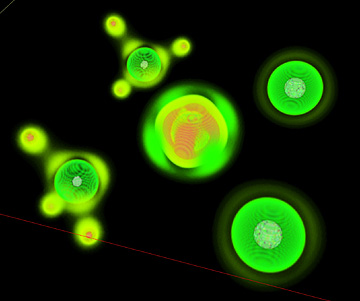 by Preston MacDougall January 17, 2005
When it happens, most cancers inflict their damage through tumors. These are nasty things that we can either feel as lumps under the skin, or see with our eyes, perhaps with the help of X-rays. These are life-sized problems, and an oncologist can describe them with references to innocent everyday objects. For instance, a "walnut-sized" brain tumor might show up in a CAT scan, or a "pea-sized" lump might be felt in a breast exam. Ultimately, however, all cancers can trace their existence back to healthy cells that somehow had a molecular problem. Molecules are really small things. I can describe their shape, but not their size, with reference to everyday objects. A molecule of deoxyribonucleic acid, or DNA for short, has the basic shape of a double-helix, but it is much too small to see or feel. DNA will always be involved in these "problems", but there must be other molecules that co-conspire in order for the problem to get out of control. Just as there are many different kinds of cancers, there are many ways that a DNA molecule, in a single cell, can develop an error in its structure, which may translate into a mistake in that cell's genetic code. Our individual genetic code largely determines our physical appearance, such as whether or not we are born with red hair. (I was, but my brother wasn't.) It is also the means by which hereditary traits are passed from one generation to the next. (My red hair was, but only to my brother's daughters. Genetics is complicated.) In addition to these familiar roles, our genetic code also orchestrates the bodily processes of living. Armies of scientists incessantly imagine, design, and conduct experiments on the molecules of life, hoping to unravel the chains of molecular events connecting physiology, both normal and abnormal, to a part, or parts, of the genetic code. For instance, the 2004 Nobel Prize in Chemistry was awarded to a trio of biochemists who were foremost in the research that led to the understanding of how the body disposes of
So what is cancer? Essentially, the genetic code of a cell has been chemically altered. This could be the result of carcinogens somehow reacting with the DNA molecule, or it could have been triggered by absorption of radiation from the sun, or it could have happened when other molecules were "reading" the code in order to make a protein. (Have you ever torn a page accidentally while reading a book?) Surprisingly, these alterations to our DNA happen all the time. Even more surprisingly, our genetic code also contains the instructions for enzymes (remember, they are the "molecular machines" in our cells) that check for errors in DNA, and fix them to boot! There are additional back-up plans, such as so-called "programmed cell death." This is analogous to the degradation of tagged proteins, but it involves the self-destruction of an entire cell. A sort of cellular panic button gets hit when there are chemical signals indicating that there is a molecular problem inside the cell that is getting out of control. When all the back-up systems fail, the problem cell can multiply and a tumor can form. I would like to stress that I am not an oncologist, and if you have questions about cancer, you should consult with your doctor. Finally, what is chemotherapy? When our body fails to destroy cancerous cells, and a tumor starts to grow, it can be surgically removed. However, to make sure that no cancerous cells are left, which could start a new tumor, high doses of radiation, and/or chemicals might be administered. Although healthy cells may also be killed, such therapies "target" cancerous cells as much as technology allows. For a given type of cancer, many chemists will spend years studying the culprit molecules in those tumors, then designing, testing, and redesigning molecules to combat them. Chemists have smart bombs too, and you can't even see them!
Preston MacDougall is a chemistry professor at Middle Tennessee State University. His "Chemical Eye" commentaries are featured in the Arts and Public Affairs portion of the Nashville/Murfreesboro NPR station WMOT (www.wmot.org).
|
|||

